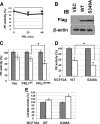Prolactin inhibits activity of pyruvate kinase M2 to stimulate cell proliferation
- PMID: 20962042
- PMCID: PMC2999476
- DOI: 10.1210/me.2010-0219
Prolactin inhibits activity of pyruvate kinase M2 to stimulate cell proliferation
Abstract
Mitogenic and prosurvival effects underlie the tumorigenic roles of prolactin (PRL) in the pathogenesis of breast cancer. PRL signaling is mediated through its receptor (PRLr). A proteomics screen identified the pyruvate kinase M2 (PKM2), a glycolytic enzyme known to play an important role in tumorigenesis, as a protein that constitutively interacts with PRLr. Treatment of cells with PRL inhibited pyruvate kinase activity and increased the lactate content in human cells in a manner that was dependent on the abundance of PRLr, activation of Janus kinase 2, and tyrosine phosphorylation of the intracellular domain of PRLr. Knockdown of PKM2 attenuated PRL-stimulated cell proliferation. The extent of this proliferation was rescued by the knock-in of the wild-type PKM2 but not of its mutant insensitive to PRL-mediated inhibition. We discuss a hypothesis that the inhibition of PKM2 by PRL contributes to the PRL-stimulated cell proliferation.
Figures







Similar articles
-
Diphenylbutylpiperidine Antipsychotic Drugs Inhibit Prolactin Receptor Signaling to Reduce Growth of Pancreatic Ductal Adenocarcinoma in Mice.Gastroenterology. 2020 Apr;158(5):1433-1449.e27. doi: 10.1053/j.gastro.2019.11.279. Epub 2019 Nov 29. Gastroenterology. 2020. PMID: 31786131 Free PMC article.
-
Growth hormone signaling in human T47D breast cancer cells: potential role for a growth hormone receptor-prolactin receptor complex.Mol Endocrinol. 2011 Apr;25(4):597-610. doi: 10.1210/me.2010-0255. Epub 2011 Feb 10. Mol Endocrinol. 2011. PMID: 21310852 Free PMC article.
-
The role of prolactin receptor in GH signaling in breast cancer cells.Mol Endocrinol. 2013 Feb;27(2):266-79. doi: 10.1210/me.2012-1297. Epub 2012 Nov 28. Mol Endocrinol. 2013. PMID: 23192981 Free PMC article.
-
Prolactin (PRL) and its receptor: actions, signal transduction pathways and phenotypes observed in PRL receptor knockout mice.Endocr Rev. 1998 Jun;19(3):225-68. doi: 10.1210/edrv.19.3.0334. Endocr Rev. 1998. PMID: 9626554 Review.
-
From the molecular biology of prolactin and its receptor to the lessons learned from knockout mice models.Genet Anal. 1999 Nov;15(3-5):189-201. doi: 10.1016/s1050-3862(99)00025-x. Genet Anal. 1999. PMID: 10596761 Review.
Cited by
-
Posttranslational modification of pyruvate kinase type M2 (PKM2): novel regulation of its biological roles to be further discovered.J Physiol Biochem. 2021 Aug;77(3):355-363. doi: 10.1007/s13105-021-00813-0. Epub 2021 Apr 9. J Physiol Biochem. 2021. PMID: 33835423 Review.
-
Pyruvate Kinase Inhibits Proliferation during Postnatal Cerebellar Neurogenesis and Suppresses Medulloblastoma Formation.Cancer Res. 2017 Jun 15;77(12):3217-3230. doi: 10.1158/0008-5472.CAN-16-3304. Epub 2017 May 17. Cancer Res. 2017. PMID: 28515149 Free PMC article.
-
A critical review of the role of M2PYK in the Warburg effect.Biochim Biophys Acta Rev Cancer. 2019 Apr;1871(2):225-239. doi: 10.1016/j.bbcan.2019.01.004. Epub 2019 Jan 29. Biochim Biophys Acta Rev Cancer. 2019. PMID: 30708038 Free PMC article. Review.
-
Pyruvate Kinase M2 and Cancer: The Role of PKM2 in Promoting Tumorigenesis.Front Oncol. 2020 Mar 2;10:159. doi: 10.3389/fonc.2020.00159. eCollection 2020. Front Oncol. 2020. PMID: 32195169 Free PMC article. Review.
-
PKM2 isoform-specific deletion reveals a differential requirement for pyruvate kinase in tumor cells.Cell. 2013 Oct 10;155(2):397-409. doi: 10.1016/j.cell.2013.09.025. Cell. 2013. PMID: 24120138 Free PMC article.
References
-
- Clevenger CV, Zheng J, Jablonski EM, Galbaugh TL, Fang F 2008 From bench to bedside: future potential for the translation of prolactin inhibitors as breast cancer therapeutics. J Mammary Gland Biol Neoplasia 13:147–156 - PubMed
-
- Clevenger CV, Gadd SL, Zheng J 2009 New mechanisms for PRLr action in breast cancer. Trends Endocrinol Metab 20:223–229 - PubMed
-
- Wagner KU, Rui H 2008 Jak2/Stat5 signaling in mammogenesis, breast cancer initiation and progression. J Mammary Gland Biol Neoplasia 13:93–103 - PubMed
Publication types
MeSH terms
Substances
Grants and funding
LinkOut - more resources
Full Text Sources
Molecular Biology Databases
Miscellaneous

